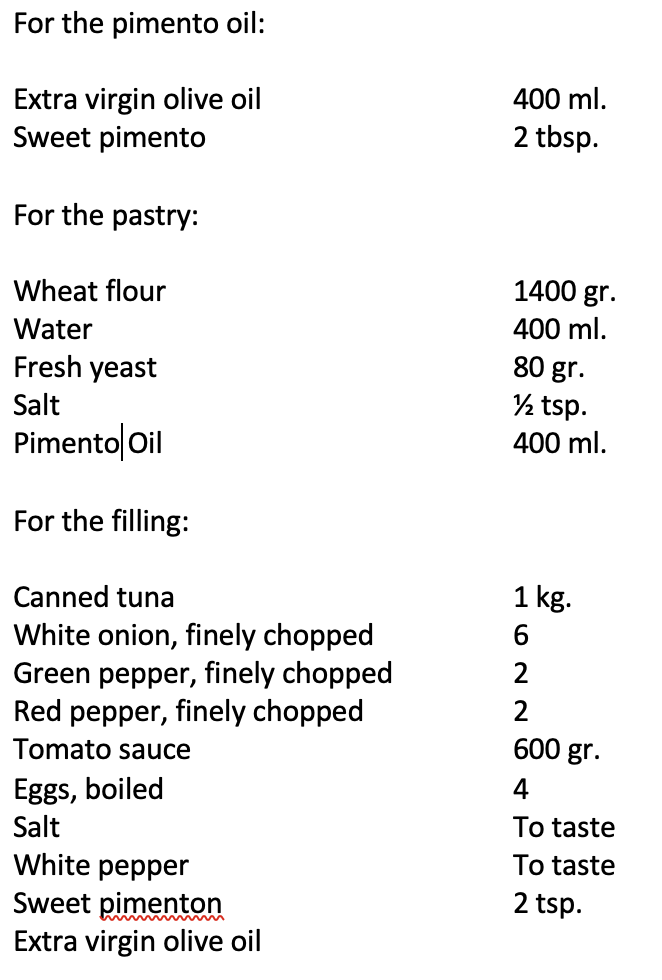Mediterranean - Fish and seafood
Recipe:
Empanada gallega
serves:
8
Method:
1. Finely chop the onions and the peppers. Heat some olive oil in a casserole and poach the onions until they are transparent. Then add the peppers and cook for 20 minutes or until they are soft. In the meantime, boil the eggs in a separate pot and reserve.
2. Add the tomato sauce, season with salt and pepper and cook for another 15 minutes to reduce any liquid from the tomato sauce. Stir in the sweet pimenton.
3. Finally, chop the boiled eggs very finely and add them to the mix. Crumble the tuna, drain it from any oil excess and add it to the sauce. Mix everything thoroughly. Remove from the heat and leave the sauce to cool. Reserve.
Making the pimenton oil:
1. Heat the olive oil in a small saucepan. Once the oil is hot, remove from the heat, stir in the pimenton and let it cool down. Once cold, sieve it and reserve.
Making the pastry:
1. Put the flour in a big bowl, making a cone shape. With the help of a spoon, model a crater in the middle so it ends looking like a flour-made volcano.
2. Dissolve the yeast in mild water. Make sure the water is not too hot or the yeast won’t rise enough.
3. Pour the water with the dissolved yeast into the flour crater. Use your hands to slowly mix the elements, until you start getting something that looks like dough crumbs.
4. Add the salt and the pimenton oil (leaving a little bit, enough to paint the pastry top later on), which should be a bit warm for optimal results.
5. Keep using your hands to mix the ingredients until you get a sticky dough
6. Sprinkle some flour over the kitchen top –or a table– and start kneading the dough with your fingers, from the inside to the outside. Manipulating the dough will get easier and easier as you knead it. Keep on doing this operation for around 7 minutes. Let it rest for 5 minutes and then knead it again for an extra 7 minutes, until we get a perfectly formed dough ball.
7. Sprinkle some flour over the bowl where you mixed the dough and place the dough ball inside. Cover with a moisturized cloth and leave it to rest for an hour. The optimal temperature for the dough to rise is around 35ºC, so please make sure you leave it in a warm place or the dough won’t rise.
8. After an hour, the dough should be double the size. Divide it in two halves: one for the pastry base and the other for the cover.
9. Pre-heat the oven at a temperature of 200ºC, with heat coming from both the top and the bottom. Roll the halves into two dough sheets –one slightly bigger than the other one– with a thickness of around 2mm. The shape can be rectangular or rounded, up to you.
10. Place the smaller dough sheet over the back of an oven dish which you have previously covered with baking paper. Spread the stuffing equally over the dough and cover with the bigger sheet, folding the edges carefully to close the pastry. Make a little hole in the middle of the top so that it allows the steam to escape.
11. Paint the top of the pastry with the leftover from the pimenton oil and bake in the oven for approximately 45 minutes or until golden. Take out of the oven and serve hot or cold.



